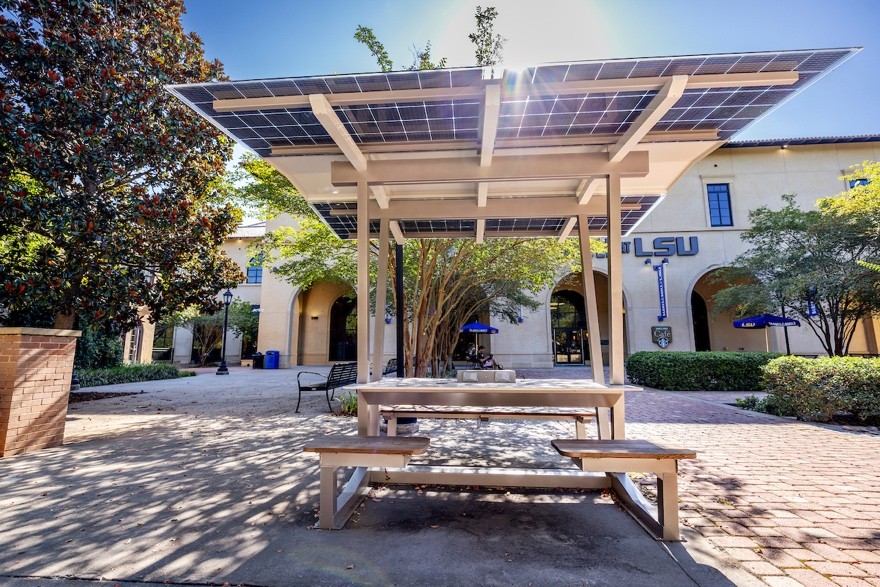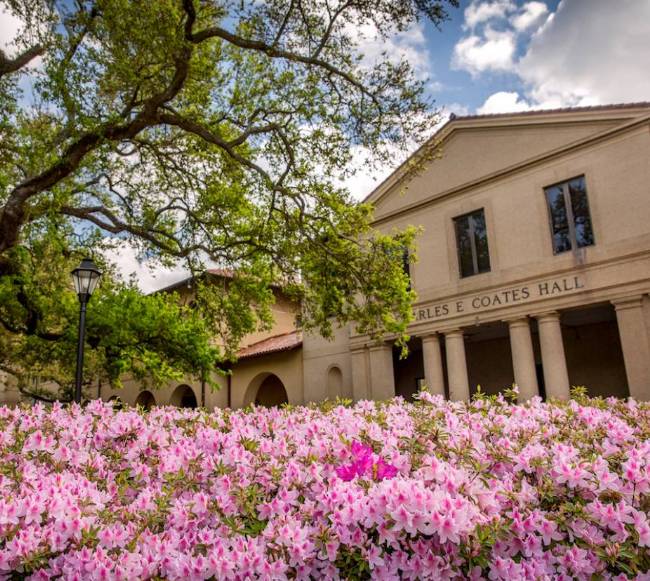Soaking up the Sun: LSU’s New Solar Shelters Provide Shade and Sustainability to Improve Campus Life
August 19, 2025
LSU is the first SEC school to place new solar-powered shelters in high-traffic areas across campus, offering students not only a shady place to study outdoors, but also a look into the future of sustainable solar energy.
This project was spearheaded by LSU’s Department of Construction Management Assistant Professor Dr. Arup Bhattacharya who was given a research grant funded by the LSU Institute for Energy Innovation.

On-campus solar shelter.
“There were three things that were the motivation behind these shelters,” Bhattacharya said. “I noticed there were not many places for students to sit outside and work, and these were perfect to enjoy those cool fall and spring evenings. We wanted to initiate research on distributed solar power generation for Louisiana, as well as, to study the impacts of Louisiana’s unique climate on the reliability of solar power.”
The solar-powered shelters improve the day-to-day experience for students by providing shaded seating, built-in lighting and charging stations powered by the sun, which improves comfort and convenience between classes.
“Research suggests that any work environment integrated with natural elements enhances productivity and retention,” Bhattacharya said. “Providing students with an opportunity to sit outside where they can use free power to juice up their devices should positively impact their daily lives on campus.”
Institute for Energy Innovation Research Coordinator Will Spatafora said this project gives the LSU community hands-on experience with sustainability.
“Projects like this showcase LSU’s leadership in sustainability, make students and visitors see renewable energy in action, and create opportunities for hands-on learning and research,” Spatafora said.
On a research and learning level, these shelters are being used to understand how productivity can be maximized in existing environments with distributed systems. Bhattacharya can use the shelters’ built-in Wi-Fi system to gather real-time data on usage patterns, including peak energy demand and charging levels at different times of day. These insights are being integrated into K–12 learning modules and undergraduate coursework.
Bhattacharya said the shelters have received excellent reviews from students, faculty, and staff.
“We have seen people enjoying a meal by the food carts in front of Patrick F. Taylor Hall, enjoying an ice cream at the Dairy Store, or getting a shady refuge on the way from campus to the residence halls,” Bhattacharya said.
“LSU Facilities staff love the design, and students are slowly realizing they can charge a wide range of devices at the shelters,” Spatafora said. “I even saw one student set up with a full PC desktop one day.”
Looking to the future, there are ideas to develop an entire network of shelters and standalone power generating stations on campus, as this would continue to support LSU’s larger sustainability goals.
“The shelters directly support LSU’s efforts to reduce its carbon footprint, promote clean energy, and integrate sustainability into visible campus infrastructure,” Spatafora said. “Projects like these not only show the benefit of collaborative work between sustainability, research, and student life, but also demonstrate the importance of having a very diverse energy portfolio not only here at LSU, but across the country.”
Next Step
As we build teams that win for Louisiana, the nation, and the world, LSU is putting our state and its citizens on firmer footing for a brighter tomorrow — one win at a time.


